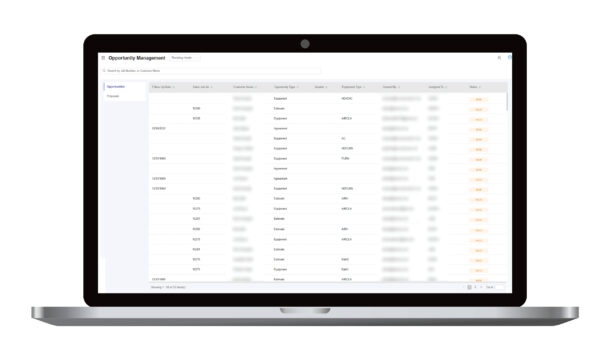Small business owners recognize the value of a powerful Customer Relationship Management (CRM) tool. Storing and tracking customer communication history, job data, maintenance agreements, equipment history, and more, the right CRM can help a business grow its customer base and increase revenue.
Many of us are most familiar with CRM software and its benefits as it relates to our sales teams. After all, they tend to be the primary users on a daily basis, capturing a wealth of useful customer information. But that same CRM data is a hidden gem for the marketing department as well.
Marketers have their work cut out for them these days. As attentions are scattered across more and more communication platforms, it has become necessary to increase marketing frequency. In fact, a potential customer usually requires about eight touches from a business or brand before a sale happens. Whether a business is looking to develop effective email marketing content, implement automation to assist with hands-free outreach or determine ROI on a campaign, CRM has tools available to help.
Just remember: it’s imperative to obtain the proper permissions from both current and potential customers before adding them to a marketing list. Once that step is taken care of, it’s time to start brainstorming your next marketing campaign and the messages you want to convey to these two different audiences.
For prospective customers, messaging is typically geared towards communicating why you are the best company and why they should want to do business with you. This is the time to separate your business from the competition, making a memorable impression that will stick with them when they go to book their next service appointment.
Since current customers are already familiar with your company and its services, the marketing message usually revolves around offering them special promotions or maintenance service agreements. Businesses may also want to provide them with helpful tips and advice that further position the company as the provider of choice in the industry and market.

CRM Tool #1 – Segment contacts for email marketing
Email newsletters can be a cost-effective marketing campaign solution to convey these different messages to both prospective and current customers. Email can help build relationships with customers and keep them coming back, and they are fairly easy to start. Even better, segmenting contacts into potential customers and current customers is generally accomplished easily within CRM systems.
For prospective customers, a newsletter is a place to feature your company’s products and services, as well as the expertise of your team. You can also include the ever-popular coupons or discounts, which typically attract new customers. They are also a great way to help increase awareness of services your company offers that people may not know about. If there is a type of job you offer but rarely have any customers who book appointments for it, offer a discount and see if it helps with awareness. Discounts are also effective for current customers who may be looking for a deal when it’s time to book an appointment.
Email newsletters also allow marketers to monitor the engagement they are achieving with these important contacts. By tracking open rates and click-through rates, a business can see what content is resonating. Sales can even use that information to follow up with a customer who may have clicked on an offer or link in the email but have not yet booked an appointment or service.
Establishing a routine cadence of email newsletter communication means your list of contacts will be seeing your brand’s name on a regular basis. Your company will be top-of-mind the next time they need a service you offer.
CRM Tool #2 – Automation
CRMs can help with automating outreach such as service reminders for upcoming appointments, maintenance agreement expirations/renewals, or reminders to schedule upcoming maintenance agreement visits. Some CRMs have the ability to create automated email sequences that potential customers will receive at predetermined intervals.
Consider automating a thank you email once a service is complete and including a link to review your business. Remind your customers that the best way to say thanks is by leaving a positive review. If they have easy access to leave a review, customers will be more likely to do so. Establishing a reputation for providing excellent service will go a long way in attracting new customers.
CRM Tool #3 – Track ROI and Lifetime Value
Over time, CRM systems will provide data that helps track the lifetime value of customers and marketing campaigns. Knowing where a customer came from, whether it was a form, website, social media, ad, etc., results in several things.
First, it allows a business to track where it gets the most leads and customer inquiries. Ads may be running on multiple channels, such as social media or local broadcast outlets. Compiling the information on where the leads are coming from helps determine where it’s worth investing more money. If an ad is not performing as well and not resulting in many customer inquiries, you may want to consider stopping the ad and putting that money towards a platform where you see a return.
Businesses can also begin to track the lifetime value of a customer based on jobs they have completed or any maintenance agreements they have. Seeing how much revenue and profit that customer has driven over time and tracking that back to the lead source helps a business determine the lifetime value of its marketing campaigns and lead sources.
These are just some of the ways CRM software can be used to develop effective marketing plans and create new marketing tools that will help recruit and retain customers. Don’t let the sales team have all the fun with CRM; encourage your marketing team to start accessing all of that valuable customer information today.
 Chris O’Grady has been in sales for 30 years, focusing on software sales for the last 20. Chris has been leading and growing sales teams for most of his career, with his most recent positions at FinancialForce and CBORD, where he led high-performing sales teams and was able to help drive tremendous growth for each company. In April 2022, Chris joined Successware as the Chief Sales Officer. He brought with him a proven history of business growth and increased sales performance. In his current role, Chris leads sales, sales operations, and customer success and is responsible for driving sales strategy.
Chris O’Grady has been in sales for 30 years, focusing on software sales for the last 20. Chris has been leading and growing sales teams for most of his career, with his most recent positions at FinancialForce and CBORD, where he led high-performing sales teams and was able to help drive tremendous growth for each company. In April 2022, Chris joined Successware as the Chief Sales Officer. He brought with him a proven history of business growth and increased sales performance. In his current role, Chris leads sales, sales operations, and customer success and is responsible for driving sales strategy.




Join the conversation: